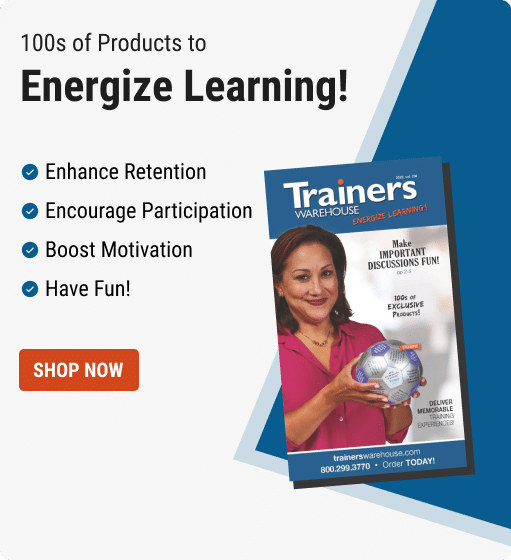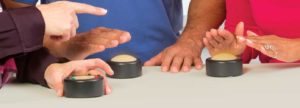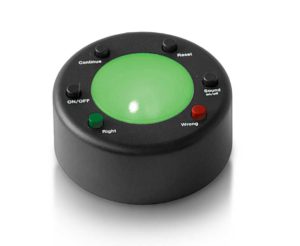Me First: A Firsthand Experience with Game Buzzers
I asked Jonathan Winkler, a seventh-grade history teacher in Newton, Massachusetts to test out a new Me First Buzzer System. At my request, he gave it to me straight and shared his Game Buzzers experience—successes and challenges.
To set the scene, understand that he introduced this snazzy new buzzer system during the last week of school, when (understandably) kids have a bit of summer fever, are looking forward to graduation, and are ready to play! Thanks to Mr. Winkler, though, for not giving up after his first class went haywire with the buzzers, slamming them before questions were even asked. Using them with several groups, here’s what he found to work best.
Trial 1: Everyone gets a buzzer
This was a way too exciting for his group. The first time Winkler introduced the buzzers to the class, players got a “slap happy,” pressing buzzers prematurely, before hearing a question or reviewing a slide. The experience became frustrating for everyone—the teachers, as well as the kids who were either slower to buzz-in or were playing by the rules and waiting for the question.
TAKEAWAYS:
- Think about when (and how) might be a good time to introduce a tool like this.
- Build in some time for the group to get accustomed to the buzzers, so the technology doesn’t draw focus from the material and the experience.
- Establish ground rules early on: for players who buzz-in too early, the facilitator will press “CONTINUE” and block them out from next questions
- Do a pre-test: Have each student buzz-in to make sure their buzzer is working.
- Consider the frustration of not being able to accumulate points because there are too many players. If you’re accommodating lots of players, consider putting people into teams.
- With 20-30 buzzers set out, facilitators may have trouble seeing which pad turned green and have to ask the student to hold it up.
Trial 2: One buzzer at each table
Given the students’ excitement, this too was a challenge. It was a bit less chaotic, but still yielded lots of early buzzing-in.
TAKEAWAYS:
- Consider putting people into small groups so they can confer on questions.
- Grouping people into smaller teams can let them feel more successful, because they can more easily accumulate points, if you’re keeping score.
- If questions are very easy to answer, many people within one group may all need access to the buzzer, and could find themselves competing with one another.
- Consider how close people need to be to one another to reach the buzzer.
Trial 3: Two Game Buzzers (Feud style)
In his third attempt, Mr. Winkler divided the students into two teams and had each team form a line. The students at the front of each line would pair up in front of the buzzers and compete to win a point for their team. Students and facilitators both found this to be most effective, and allowed the group to focus on the content, not the buzzers.
Game Buzzers TAKEAWAYS
- This format worked well for rapid-fire questions.
- Facilitators will need to have lots of questions on hand.
- If your group is fast to buzz-in, try reading your questions (Jeopardy-style) instead of integrating the experience with a PowerPoint
- For large classes, the one-at-a-time format could leave students standing idle for too long a time.
- If neither of the front two players knows an answer, you can invite them to pass to the next teammate in line, or confer with their team.
Me First Buzzers, inside and out
In spite of his early frustrations facilitating the reinforcement games, Mr. Winkler did find the buzzers to add fun and excitement to his end-of-year review. If he were to do it again, Winkler said he’d likely stick with a 4-player system because it worked best in his classroom. He also mentioned being impressed with the buzzers’ functionality:
- INCREDIBLY DURABLE: The students were very rough with the buzzers (“they were slamming them really hard,” Mr. Winkler said), and a buzzer occasionally fell on the floor, yet they always seemed to turn back on afterward.
- THE CONTINUE BUTTON: Having the ability to hit “continue” and block out previous responders was a huge help to the facilitator. It allowed the teacher to dissuade players from buzzing in early and enable slower thinkers a turn to play.
- SOUNDS: Although they’re not always used, it’s nice to be able to indicate if an answer is right or wrong. And, according to Mr. Winkler, “The students really loved the sounds! Sometimes I would forget to hit the correct button and they would quickly request that I do that.”
- BATTERIES: With three batteries in each pad, facilitators may be concerned about having to change them all at once. While we have never heard of this, we have recently updated the battery door to have a latch instead of a screw so that changing batteries is a little easier (AVAILABLE 2020). While this will make it easier to change the batteries, it invites the chance that the batteries could come out, if the PAD falls on the floor. (This did happen once to Mr. Winkler).
- TURN OFF: Conveniently, the facilitator can turn off all the Player pads by turning off the Facilitator PAD. Remember, to turn the units on or off, you must press-and-hold the on/off button for 3 to 5 seconds.
- MULTIPLE CLASSROOMS: so that two or more classrooms in close proximity can use the buzzer systems concurrently, without interference, the player buzzers are set to “match” to the facilitator pad for the first 5 minutes of use. After that, additional player pads will not communicate back and forth to the facilitator pad. NOTE: [AVAILABLE 2020] Earlier versions do not have this capability. Given the “matching” function of Me First v.3, we recommend that you:
- Power on extra buzzers for anyone you anticipate to be late to class
- Power on an extra buzzer if you want to have a back-up
- If an issue arises, power off the facilitator remote, then power them all back on, press RESET, and you’re good to go.
As always, it’s best to know your group and have some alternative ideas in your back pocket, in case “plan A” doesn’t go as expected.
READ MORE
Facilitating Jeopardy-like Games




I purchased the Me First buzzers a while back and made a rookie trainer mistake. I didn’t take the time to fully understand them or test different ways to use them prior to their first use. This is a great article. I think it would be helpful to include this with any new purchases of this item. Thanks for posting.
Best regards,
Valerie